Cite as: "a rare case report of intestinal hymenolepiasis and ascariasis double infection in a symptomatic immuno-competent host from south india".; vol. 2 issue 11 pg:1443-1447
International Journal Of Medical Science And Clinical Inventions
Volume 2 issue 11 2015 page no. 1443-1447 e-ISSN: 2348-991X p-ISSN: 2454-9576
"A Rare Case Report Of Intestinal Hymenolepiasis And Ascariasis
Double Infection In A Symptomatic Immuno-Competent Host
From South India".
Dr. R. Someshwaran1, SM. Nachammai2, Dr. Anbu N. Aravazhi3
Corresponding author: Dr. R. Someshwaran
Department of Microbiology, Karpagam Faculty of Medical Sciences and Research, Coimbatore, Tamil
Nadu 641032 India
Abstract:
A 30 year old immuno-competent female, a home maker by occupation, belonging to class III Modified Prasad's
classification presented to medicine out-patient department with complaints of diarrhea 6-8 episodes per day, anal pruritus,
lower abdominal pain, vomiting and nausea for about 10 days. Patient also complained of malaise and low grade fever on
and off for the past two weeks. No other history of similar complaints in the family. On examination patient was afebrile and
had moderate pallor. Routine laboratory blood investigations revealed profound eosinophilia and moderate anemia. Stool
specimen was sent to Diagnostic Microbiology Laboratory for microscopic examination which revealed presence of
helminthic co-infection namely Hymenolepis nana and Ascaris lumbricoides. Patient was de-wormed with specific anti-
helminthic therapy and the patient improved symptomatically and was subsequently discharged. Follow up microscopic stool
re-examination done at 10 days and 18 days after the treatment revealed no parasitic ova or cyst.
Key words: Geohelminthiasis - Hymenolepis nana - Ascaris lumbricoides - Polyparasitosis – Immunocompetent female –
Anemia.
Introduction:
and also among high risk ethnic groups. Moderate loads of
parasitic infection could cause delayed physical and
symmetrical elongated, flat or round worm-like soil
impaired cognitive development especially in school age
transmitted parasites. Geohelminths are broadly classified
children10, 11. STH is the leading infectious cause for illness,
into Platyhelminths and Nemahelminths.
Platyhelminths
absenteeism12 and lost Disability Adjusted Life Years
include a) flat tape like cestodes or tape worms and b) flat
leaf-like trematodes or flukes whereas
Nemahelminths
includes elongated cylindrical nematodes (round worms).
"Double and triple infections"
Geohelminthiasis1 or Soil Transmitted Helminthic (STH)
„Polyparasitosis‟ are accidental infections but not so
Ancylostoma
duodenale,
uncommon and they occur due to i) availability of the
americanus, Ascaris lumbricoides2 and Trichuris trichiura
infective forms of different parasites in the same place and
etc., still remains as the most common worm infestations
during the same time of exposure; ii) direct person to person
feco-oral transmission; iii) through contaminated soil, water
gastrointestinal tract4 and are found ubiquitous in tropical
or food without involving intermediate host; iv) Parasitic
and sub-tropical temperate zones posing significant public
symbiosis; v) Immunocompromised host; vi) Parasitic
health problem5, 6 to humans. Estimated prevalence of geo-
synergism. Complex etiology of these parasites and
helminthiasis is around 2 billion cases comprising 28.6% of
variation in distribution15, 16 makes it very difficult to
the world‟s population1. Among them Ascariasis alone
consolidate the „cause and effect‟ indices where these STH
accounts for one billion cases worldwide. The developing
infections has a negative impact over physical and mental
countries contribute to about 10% of these parasitic
agility of the patient17 thwarting the efforts of a country to
infections7. The prevalence rate of intestinal helminthic
provide basic amenities of the community like free school
infections in India is 12.5% but a higher incidence of up to
education18, mid-day meal program and other health related
66% has been reported8, 9, where individual parasitic
20. Feco-oral transmission of
incidence may vary among different geographical locations
Hymenolepis nana and
Ascaris lumbricoides by ingestion of
DOI: 10.18535/ijmsci/v2i11.04
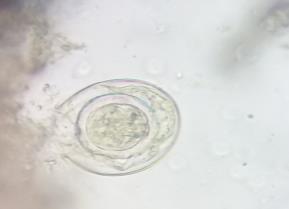
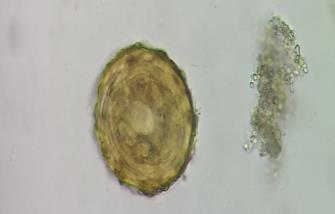
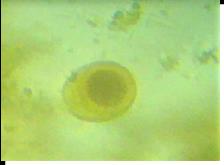
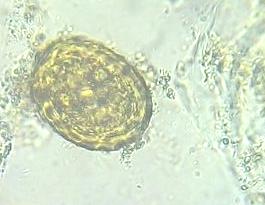
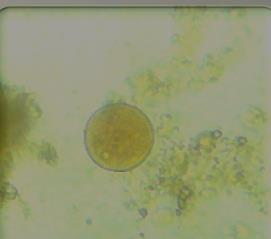
Cite As: "A Rare Case Report Of Intestinal Hymenolepiasis And Ascariasis Double Infection In A
Symptomatic Immuno-Competent Host From South India".; Vol. 2 Issue 11 Pg:1443-1447 2015
fertilized eggs is the most common method of transmission.
parasitic morphologies. One type was roughly 40µm
Infections are generally asymptomatic in low burden cases
diameter size, oval, colorless eggs (non-bile stained) with
but in high burden cases the signs and symptoms may vary18
outer and inner membranes, 4-5 polar filaments, hexacanth
viz., abdominal pain, nausea, vomiting, fever, weight loss,
embryo with three pairs of hooklets (oncosphere) which was
irritability, diarrhea, sleep disorders, pruritus etc. Estimated
found to be Hymenolepis nana, a cestode and the other were
mortality worldwide due to STH is 1,35,000 deaths per
60µm diameter size, Oval to sub-spherical golden brown
21. The complications of ascariasis and
eggs (bile stained) with thick shell covered by albuminous
hymenolepiasis hyper-infection17 include biliary tract
coat and a large unsegmented ovum with crescentic area at
obstruction, intestinal obstruction, failure to thrive, protein
each pole which was confirmed as fertilized egg of Ascaris
energy malnutrition, cognitive impairment, iron deficiency
lumbricoides, an intestinal nematode. Also colorless,
anemia, eosinophilic pneumonitis, appendicitis, peritonitis
spherical, 15-20µm pentanucleate to octanucleate cyst (5-8
and death especially in case of those untreated patients 22, 23.
nuclei) were present which was further identified as
Mortality due to polyparasitosis had reduced due to anti-
commensal cysts of Entamoeba coli. No evidence of
helminthic self-medication24, 25. To reduce disease burden of
trophozoites with ingested erythrocytes suggestive of
STH, WHO recommends a feasible and cost effective
Entamoeba histolytica.
control strategy of parasitic infections by single dose
chemotherapy for ascariasis, trichuriasis and hook worm
Figure1: Stool microscopy for ova or cyst.
infestations especially targeting school age children18.
a) Saline wet mount preparation (40X objective): Oval non-
bile stained egg of
CASE DESCRIPTION:
Hymenolepis nana and spherical bile stained fertilized
A 30 year old immuno-competent female presented
egg of Ascaris lumbricoides.
to the medicine out-patient department with chief complaints of passing loose stools 6-8 episodes per day, anal pruritus, lower abdominal pain, vomiting and nausea for 5-6 days. Patient revealed history of easy fatigability, irritability, excessive tiredness and loss of appetite for past 10 days. Patient also complained of malaise, low grade fever
on and off for the past two weeks. No history of joint pain.
Hymenolepis nana
Ascaris lumbricoides
No history of contact with animals. No history of similar
complaints among the family members. No history of
consuming deworming pills in the last six months. On
b) Iodine wet mount preparation (40X objective): Eggs of
examination patient was afebrile, with mild-moderate pallor.
Hymenolepis nana and
Routine laboratory blood investigations revealed profound
fertilized egg of Ascaris lumbricoides seen. Multiple cysts
eosinophilia and moderate anemia. A working diagnosis of
of Entamoeba coli
suspected helminthic infection with anemia was made and
were seen.
stool specimen was sent to diagnostic microbiology
laboratory for examination.
Materials and methods:
Institutional Human Ethics Committee (IHEC)
clearance and patient‟s informed consent were obtained.
Entamoeba coli
Hymenolepis ana
Ascaris lumbricoides
Stool sample was collected in a sterile wide mouthed screw
(5-6µm)
capped plastic container as per guidelines and was sent for
microscopic and macroscopic examination to diagnostic
Entamoeba coli
microbiology laboratory, Karpagam Medical College
Repeat stool re-examination for parasitic ova or cyst done
(5-6µm)
Hospital affiliated to Karpagam Faculty of Medical Sciences
10 days and 18 days after the course of treatment which
& Research. Direct macroscopic examination revealed
were negative for Hymenolepis nana and Ascaris
loose, yellowish brown, malodorous soft stool mixed with
lumbricoides.
mucus. No evidence of admixed blood or worm segments
seen. Stool microscopy by Saline wet mount and Iodine wet
Discussion:
mount preparations revealed presence of two different
In this patient, anemia (Serum Hemoglobin-
8.1g/dL) and eosinophilia were the hallmark blood findings
DOI: 10.18535/ijmsci/v2i11.04
Cite As: "A Rare Case Report Of Intestinal Hymenolepiasis And Ascariasis Double Infection In A
Symptomatic Immuno-Competent Host From South India".; Vol. 2 Issue 11 Pg:1443-1447 2015
which could be explained due to complications26, 27 of
Even today soil transmitted intestinal helminthiasis
Hymenolepiasis and Ascariasis. The patient was treated with
is a highly prevalent but neglected disease claiming global
oral mebendazole 100mg bd for 3 days. Patient improved
public health importance13. STH is the most common cause
symptomatically and was discharged from the hospital.
for chronic infection in humans in developing countries32.
Mixed hymenolepiasis and ascariasis double infection are
High parasitic infestation mirrors severe shortage in health
far more reported outside India28. Only a few published
care and education, transport and chronic poverty33.
cases of mixed helminthic infections were reported
Widespread use of anti-helminthic therapy had shown
worldwide. No reports of helminthic polyparasitosis were
remarkable reduction in burden of STH infection in South
found in South India. Patients with intestinal parasitosis are
India34.Risk of developing drug resistance due to frequent
carriers transmitting the disease infection to nearby contacts
anti-helminthic use leading to widespread drug resistance in
and also to the community. According to a recent study
nematodes35. Multiple parasitic infections are far more
report, the prevalence rates of individual parasites like
common than single or no infection17. Polyparasitism with
Ascaris lumbricoides and Hymenolepis nana among people
nematodes is a common occurrence 24. Polyparasitism
living in high risk areas of South India were found to be
6.2% and 2.7% respectively29.
„Deworming‟ is an essential tool of school health programs
to control STH infections21. Following repeated deworming
Risk factors for STH infections7, 8, 9, 18 at both
once in 3-6 months, a rise in haemoglobin levels (0.1-2 g/dl)
individual and at community levels is an amalgamation of
has been observed after 1 year in some studies36, 37.
complex and multivariate Demographic, Biological, Social,
Environmental, Climatic, and Behavioral factors viz., i)
Conclusion:
Over-crowding; ii) Illiteracy; iii) Unemployment iv)
A precise, feasible and cost-effective a) Diagnostic,
Poverty; v) Poor personal hygiene like hand hygiene, toilet
b) Therapeutic and or c) Preventive strategy is mandatory as
hygiene and sex hygiene; vi) Regional customs and
a stepping stone for prevention of disease progression and or
traditions; vii) Poor environmental sanitations; viii) Infected
its complications is the strict adherence to regular or
food handling expatriates; ix) Open air-defecation in drains,
periodic health screening by microscopic stool examination
fields or streets; x) Consuming raw vegetables like tubers
especially in endemic areas and among high risk groups
and greens; xi) Consuming undercooked consumables like
which would be more helpful in the early diagnosis and
vegetables and meat; xii) Unemployment, xiii) Lack of
home or private toilet facility, xiv) Not washing hands after
infections18. Periodic treatment with anti-helminthic drugs
defecation, xv) Living in warm moist environment and also
for control of intestinal parasitic infection for the community
in shanty tribal , rural or urban area, xvi) History of contact
is a highly effective and inexpensive tool but a more precise
with animals (cattle and pig rearing; household pets like cats
study emphasizing on the epidemiology of STH and its drug
and dogs; pests like rats and mice), xvii) Consuming organic
resistance before making large scale periodic treatment
food (those untreated with insecticides); xviii) Post-
schedules on a global basis is a borne necessity38. Preventive
monsoon period (November to February) or rainy season;
measures to control STH are health education, periodic
xix) Due to consumption of improperly preserved or cooked,
contaminated road side fast food and junk foods ; xx)
environmental sanitation and personal hygiene, quality
History of PICA, playing in the moist soil or mud.
nutrition, political will and terminating the chain of disease
Risk Groups (HRG) for Geo-helminthiasis are a) People
transmission. Reporting any case of polyparasitosis and
living in tropical and temperate regions; b) Dwellers of
other complicated parasitic infections is important in order
"Kuccha house" with thatched roof and cow dung flooring
to understand their clinical spectrum, enhance the
or in Field huts; c) School age children; d) walking with
knowledge on epidemiology, adherence to standard
bare foot in „Fecal fields‟; e) Habitual eaters of food that has
treatment protocols and to combat the drug resistance 18.
fallen on the ground, f) Occupation – Farmers,
Veterinarians, Food handlers working in hotels, bakeries,
References:
nursing homes and hospitals, g) Presence of untrimmed and
1. Deepthi Kattula, Rajiv Sarkar, Sitara Swarna Rao
or long contaminated nails, h) those who had not taken
deworming tablet in last 6 months; i) Homosexuals, Male
Jayaprakash Muliyil and Gagandeep Kang. Prevalence
and Female sex workers30, 31.
& risk factors for soil transmitted helminth infection
among school children in south India. Indian J Med Res 2014; 139, pp 76-82.
DOI: 10.18535/ijmsci/v2i11.04
Cite As: "A Rare Case Report Of Intestinal Hymenolepiasis And Ascariasis Double Infection In A
Symptomatic Immuno-Competent Host From South India".; Vol. 2 Issue 11 Pg:1443-1447 2015
2. Cooper ES, Bundy DA. Trichuris is not trivial.
among food handlers in Western Iran. Rev. Inst. Med.
Parasitology Today 1988; 4:301-306.
Trop. Sao Paulo 2014; 56(2):111-114.
3. Roche M, Layrisse M. The nature and causes of
16. de Silva NR. Impact of mass chemotherapy on the
"hookworm anemia". American Journal of Tropical
morbidity due to soil-transmitted nematodes. Acta
Medicine and Hygiene 1966; 15:1029-1102.
Tropica 2003; 86:197-214.
4. O'Lorcain P, Holland CV. The public health importance
17. Drake LJ, Bundy DA. Multiple helminth infections in
of Ascaris lumbricoides. Parasitology 2000; 121:S51-
children: impact and control. Parasitology 2001;
5. Stephenson LS, Holland CV, Cooper ES. The public
18. Bong Jin Kim, Kyung Seob Song, Hyun-Hee Kong,
health significance of Trichuris trichiura. Parasitology
Hee-Jae Cha and Meesun Ock. Heavy Hymenolepis
2000; 121:S73-95.
nana Infection Possibly Through Organic Foods: Report
6. Crompton DW. The public health importance of
of a Case. Korean J Parasitol 2014; Vol. 52, No. 1: 85-
hookworm disease. Parasitology 2000; 121:S39-50.
7. Ramesh GN, Malla N, Raju GS, Sehgal R, Ganguly
effectiveness and increasing the benefit to education. A
NK, Mahajan RC, et al. Epidemiological study of
Guide for Program Managers. The Partnership for
parasitic infestations in lower socio-economic group in
Child Development, Oxford 1999.
Chandigarh (north India). Indian J Med Res 1991; 93:
20. World Health Organization (WHO).1. Eliminating soil
transmitted helminthiases as a public health problem in
8. Singh P, Gupta ML, Thakur TS, Vaidya NK. Intestinal
children. Progress Report 2001-2010 and Strategic
Parasitism in Himachal Pradesh. Indian J Med Sci 1991;
Plan 2011-2020. Geneva: WHO; 2012.
45: 201-4, 200.
21. Savioli L, Albonico M, Engels D, Montresor A.
9. Singh S, Raju GV, Samantaray JC. Parasitic gut flora in
a north Indian population with gastrointestinal
schistosomiasis and soil-transmitted helminthiasis.
symptoms. Trop Gastroenterol 1993; 14: 104-8.
Parasitology International 2004; 53:103-113.
22. Holland CV, Asaolu SO. Ascariasis in Nigeria.
10. Curtale F, Pezzotti P, Saad YS, Aloi A. An analysis of
Parasitology Today 1990; 6:143-147.
Individual, household, and environmental risk factors for intestinal helminth infection among children in Qena
23. Stephenson L, Latham M, Adams E, Kinoti S, Peter A.
Governorate, Upper Egypt. J Trop Pediatr 1999; 45:
Weight gain of Kenyan school children infected with
hookworm, Trichuris trichiura and Ascaris lumbricoides is improved following once- or twice-yearly treatment
11. Ostan I, Kilimcioglu AA, Girginkardesler N, Ozyurt
with albendazole. Journal of Nutrition 1993; 123:656
BC, Limoncu ME, Ok UZ. Health inequities: lower
socio-economic conditions and higher incidences of
24. Ayanwale FO, Esuruoso GO, Dipeolu OO. The
intestinal parasites. BMC Public Health 2007; 7: 342.
epidemiology of human intestinal helminthiasis in
12. Curtale F, Pezzotti P, Sharbini AL, al Maadat H,
Ibadan, South Western Nigeria. International Journal of
Ingrosso P, Saad YS, et al. Knowledge, perceptions and
Zoonoses 1982; 9:69-72.
behavior of mothers toward intestinal helminths in
25. Akogun OB. Some social aspects of helminthiasis
Upper Egypt: implications for control. Health Policy
among the people of Gumau District, Bauchi State,
Plan 1998; 13: 423-32.
Nigeria. Journal of Tropical Medicine and Hygiene
13. Olaniyi J. Ekundayo, Muktar H. Aliyu , Pauline E.
1989; 92:193-196.
Jolly. A review of intestinal helminthiasis in Nigeria
26. Rahif, R.H. and Al-Saadi, M.A-Z. Epidemiology of
and the need for school-based intervention. Journal of
Hymenolepis nana (cestoda) infection among children
Rural and Tropical Public Health 2007; 6: 33-39.
in Baghdad (Iraq). Iraqi J. of Vet. Med. 2001; Vol.25,
Chan MS. The global burden of intestinal nematode infections - fifty years on. Parasitology Today 1997;
27. Al-Hindi, A.I. and El-Kichaoi, A. Occurrence of
gastrointestinal parasites among pre-school children, Gaza, Palestine. The Islamic University Journal 2008;
15. Farnaz kheirandish, Mohammad Javad tarahi, and
Vol.16, No.1, pp.125-130.
Behrouz ezatpour. Prevalence of intestinal parasites
DOI: 10.18535/ijmsci/v2i11.04
Cite As: "A Rare Case Report Of Intestinal Hymenolepiasis And Ascariasis Double Infection In A
Symptomatic Immuno-Competent Host From South India".; Vol. 2 Issue 11 Pg:1443-1447 2015
28. Mariwan Musa Muhammad Bajalan. Epidemiological
study of Hymenolepis nana in children in Kalar city / Sulaimani province. Diyala Journal for Pure Sciences 2010; Vol: 6 No: 4.
29. Begna Tulu1, Solomon Taye and Eden Amsalu.
Prevalence and its associated risk factors of intestinal parasitic infections among Yadot primary school children of South Eastern Ethiopia: a cross-sectional study. BMC Research Notes 2014, 7:848.
30. Ismid S, Rukmono B. Nail and dust examination for
helminth eggs in orphanages. In: collected papers on the control of soil transmitted helminthiases II. Vol5. Asian Parasite Control Organisation 1983; 1-53.
31. Hoa NTV, Noda S, Uga S, Thuan LK, Aoki Y,
Fujimaki Y. Parasite egg contamination of hands in a suburban area of Hanoi, Vietnam. Trop Med Health 2010; 38: 75-9.
32. Awasthi S, Bundy DA, Savioli L. Helminth infections.
British Medical Journal 2003; 327:431-433.
33. Crompton DW. How much human helminthiasis is
there in the world? Journal of Parasitology 1999; 85:397-403.
34. Horton J. Global anthelmintic chemotherapy programs:
Learning from history. Trends Parasitol 2003; 19: 405-9.
35. Rajendran R, Sunish IP, Mani TR, Munirathinam A,
Arunachalam N, Satyanarayana K, et al. Community-based study to assess the efficacy of DEC plus ALB against DEC alone on bancroftian filarial infection in endemic areas in Tamil Nadu, South India. Trop Med Int Health 2006; 11: 851-61.
Ananthakrishnan,
programme for control of geohelminths: A perspective. The National Medical Journal of India 2001; VOL. 14, NO. 3.
37. Yong WL, Zhaohua X, Ying YS, Long SY, Ping RS,
Changcun S. A ten-year longitudinal observation on the control of hookworm and other soil-transmitted nematodiasis in the study site. Chinese} Parasitic Dis Control 1998; 11:165-7.
38. Fallah M, Mirarab A, Jamalian F, Ghaderi A.
Evaluation of two years of mass chemotherapy against ascariasis in Hamadan, Islamic Republic of Iran. Bull World Health Organ 2002; 80: 399-402.
DOI: 10.18535/ijmsci/v2i11.04
Source: http://www.valleyinternational.net/ijmsci/v2-i11/4%20ijmsci.pdf
3 month follow up reportWith summary of the other evaluation reports Table of contents Learner demographics Learner satisfaction Scientific programme Event organisation Teaching effectiveness Learning effectiveness Immediate post-event survey results compared to pre-event survey results Three month follow up results Learner demographics Learner demographics – Profession
Cómo referenciar este artículo / How to reference this article Gelabert Gual, Ll. (2014). Ideario y aportaciones metodológicas de Baltasar Bibiloni a la enseñanza musical en las Islas Baleares. Foro de Educación, 12(17), pp. 147-163. Ideario y aportaciones metodológicas de Baltasar Bibiloni a la enseñanza musical en












